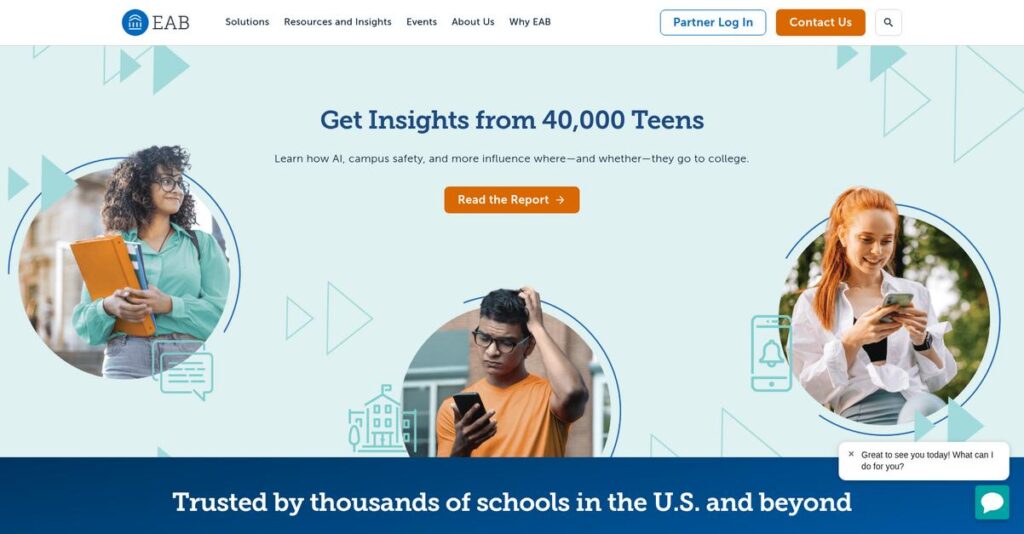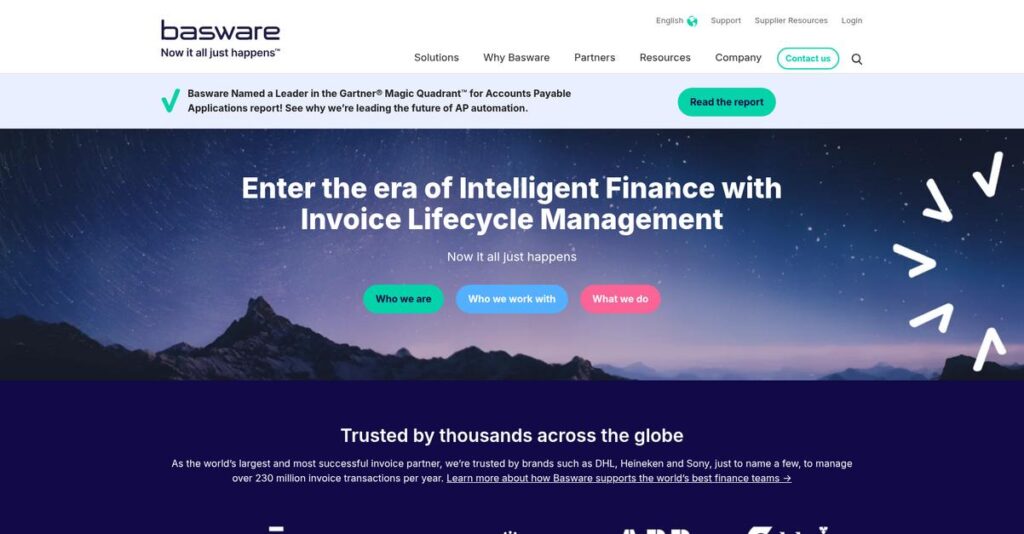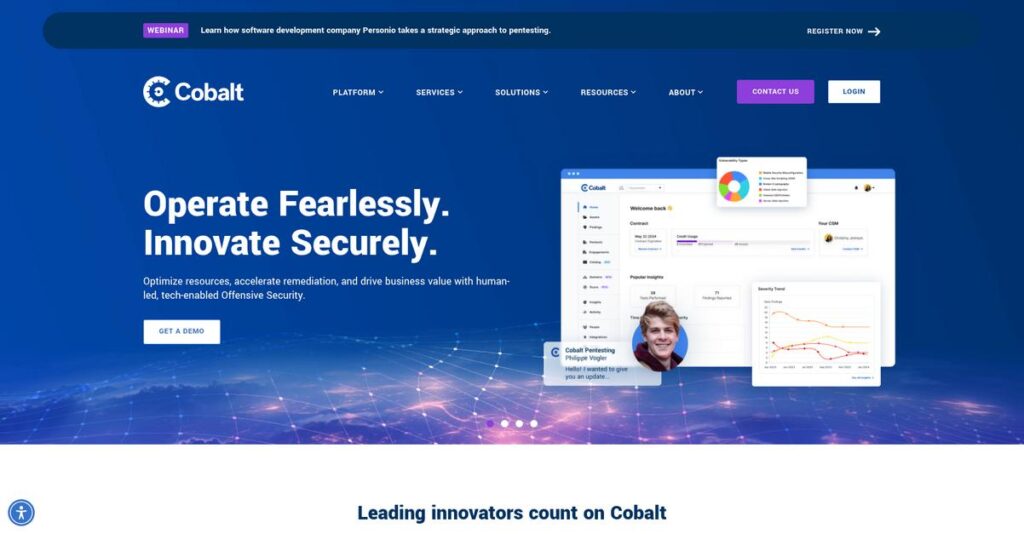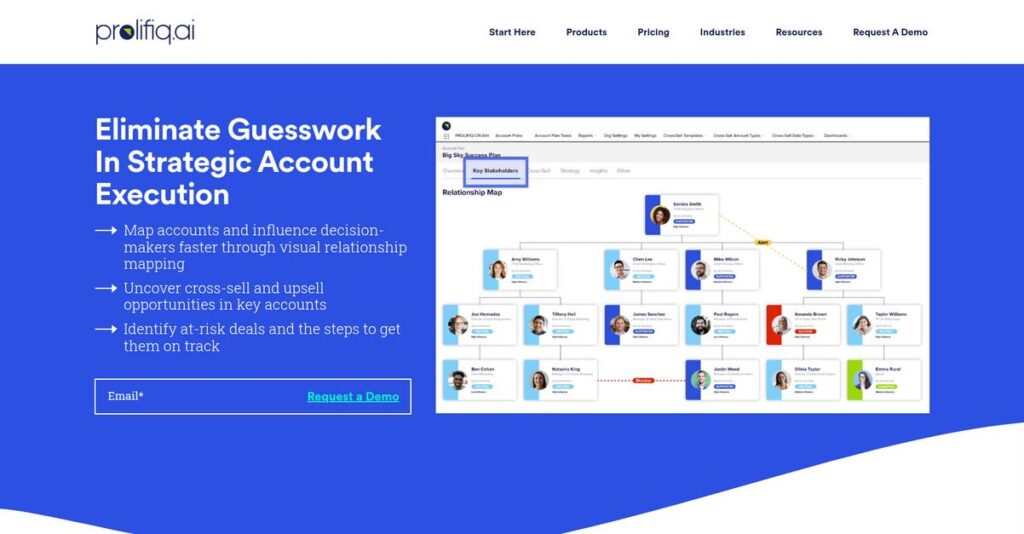Student data stuck in silos again?
If you’re dealing with disconnected systems, struggling to spot at-risk students, or hit-or-miss enrollment campaigns, you’re probably exploring solutions like EAB to finally connect the dots.
In my analysis of EAB, research insight: wasted time and frustrated staff cripple results when software can’t unify processes or data across departments.
What I discovered is EAB’s approach centers on full integration—combining predictive analytics, centralized student support, enrollment marketing, and hands-on advisory partnerships—where your team doesn’t just get a tool but ongoing strategy help.
In this EAB review, I’ll break down how integrated insights drive smarter student outcomes and whether EAB actually fixes the workflow headaches plaguing your office.
You’ll get a walkthrough of their platform, a close look at real EAB features, pricing transparency, strategic implementation tips, and how EAB stacks up to top alternatives if you’re still comparing options.
The features you need to finally reach your student success, enrollment, and advancement goals are all here—lined up for clear decision-making.
Let’s get started.
Quick Summary
- EAB is a strategic partner combining data-driven software and expert advisory to improve student success and enrollment in higher education.
- Best for mid-to-large colleges needing integrated technology plus deep guidance for complex institutional goals.
- You’ll appreciate its dedicated strategic leadership and unified analytics that help your team intervene effectively and lead change.
- EAB offers customized multi-year partnerships with no free trial and significant investment based on institution size and services.
EAB Overview
EAB has operated in its current form since 2017, with headquarters in Washington, D.C. What impressed me is their focused mission: helping education leaders solve their most pressing institutional challenges.
From my research, they don’t just sell you software; they position as a strategic partner for higher education. You’ll notice this unique approach in their blend of data technology and deep advisory services for mid-market and enterprise institutions.
Recent developments, like expanding their Edify data platform, are smart moves I noted for this EAB review. This shows a clear commitment to giving you better integrated analytics.
Unlike competitors such as Slate or Anthology who often lead with software features, EAB’s approach feels different. My analysis shows their key differentiator is the high-touch partnership model itself, which is powered by their extensive proprietary research.
They work with over 2,500 colleges and universities, which is a significant validation. This includes private institutions, large public flagships, and community colleges, proving their model’s relevance across the sector.
I found their strategic focus is providing a holistic, 360-degree view of the entire student journey. This directly addresses your institution’s need for connected data to make smarter decisions about enrollment, success, and alumni engagement.
Speaking of connected data to make smarter decisions, my guide on best academic advising software provides further insights.
Now let’s examine their core solutions.
EAB Features
Higher education faces unique, complex challenges.
EAB offers an integrated suite of solutions blending technology with strategic services to tackle these issues head-on. These are the five core EAB solutions that empower institutions to drive student success and operational efficiency.
Before diving deeper, you might find my analysis of best GST Rate Finder Software helpful for overall business operations.
1. Navigate (Student Success Management System)
Are students falling through the cracks?
Disconnected campus support systems often lead to lower retention and delayed graduation rates. This fragmented approach frustrates everyone involved.
Navigate unifies students, advisors, and faculty, solving those coordination headaches. What impressed me most is how predictive analytics identify at-risk students proactively. This EAB solution also helps advisors manage caseloads and appointments efficiently.
You gain a comprehensive student view, enabling personalized support that directly improves retention and on-time graduation outcomes.
2. Enrollment Services (Marketing & Recruitment)
Struggling to hit enrollment goals?
Meeting enrollment targets in a competitive market requires more than generic outreach. It often means inefficient spending and missed opportunities.
EAB’s Enrollment Services designs multi-channel marketing campaigns powered by decades of student data. What I love about this approach is how predictive models target right-fit students most likely to apply and succeed. This solution optimizes your marketing spend.
Your admissions office gains highly personalized, data-informed outreach, shaping your incoming class and ensuring efficient recruitment efforts.
3. Edify (Data & Analytics Platform)
Campus data stuck in silos?
Disparate data sources across campus make it impossible to gain a holistic operational view, hindering strategic decision-making.
Edify integrates information from your SIS, LMS, and CRM into one reliable cloud-based platform, eliminating data fragmentation. This is where EAB shines, as it provides a 360-degree institutional view for leaders, enabling custom analytics.
You gain unified, real-time insights into institutional health, allowing data-driven decisions without massive internal data warehouse efforts.
4. Advancement Marketing Services
Declining alumni engagement?
Generic fundraising appeals often fail to resonate, leading to lower alumni participation and donation rates, impacting institutional growth.
This solution leverages EAB’s data analytics prowess to segment alumni and develop targeted campaigns. What makes this different is how it crafts personalized outreach highlighting specific interests. This helps your advancement office move beyond mass emails.
You can achieve higher engagement and donation conversion rates, fostering stronger, more profitable relationships with your alumni base.
5. Strategic Advisory & Research
Need expert guidance and insights?
Navigating complex higher education challenges demands more than just software; institutions truly need strategic leadership and best practices.
EAB provides a human intelligence layer, offering best-practice research, market analysis, and executive roundtables. This is where EAB gets it right, as their strategic guidance is invaluable, separating them from pure-play SaaS.
You gain access to critical insights and expert support, ensuring your technology adoption is successful and drives necessary campus-wide change.
Pros & Cons
- ✅ Strategic partnership with dedicated expert guidance
- ✅ Powerful data-driven insights for student and institutional health
- ✅ Effective tools for proactive student intervention and engagement
- ⚠️ User interface can feel clunky or less intuitive for daily tasks
- ⚠️ Implementation is a significant, resource-intensive, long-term project
What I love about these EAB solutions is how they collectively form an integrated partnership model, extending beyond just software. They work together to address complex institutional challenges holistically, providing comprehensive value.
EAB Pricing
Wondering what custom pricing truly means for your budget?
EAB pricing is based on a highly customized partnership model, which means you’ll receive a quote tailored to your institution’s specific size, needs, and strategic engagement level. This approach ensures you pay only for the solutions you truly need for your higher education challenges.
Cost Breakdown
- Base Platform: Low-to-mid six figures annually; seven figures for large university systems
- User Licenses: Included in comprehensive partnership fee (varied by institutional FTE)
- Implementation: Strategic guidance & data integration support included; significant internal staff time required
- Integrations: Included as part of data integration support for core systems
- Key Factors: Institutional size (FTE), specific solutions, depth of engagement, multi-year commitment
1. Pricing Model & Cost Factors
Their custom quotes lead the way.
EAB’s pricing operates on an annual subscription/partnership fee, typically involving multi-year commitments (3-5 years). What I found regarding pricing is that costs are driven by your institution’s FTE, the specific EAB solutions like Navigate or Edify, and the depth of strategic advisory services you opt for.
Speaking of specialized care, my guide on Applied Behavior Analysis software covers essential strategies.
From my cost analysis, this means your investment aligns directly with your institution’s scale and the comprehensive support you receive.
2. Value Assessment & ROI
Is this investment worthwhile for you?
EAB is a premium-priced solution, but you’re buying a strategic partnership, not just software. What makes their pricing different is the combined value of technology and expert advisory, leading to improved student success and enrollment. This comprehensive approach often delivers significant ROI by solving complex institutional challenges more effectively than standalone tools.
From my cost analysis, this means your budget gets a holistic solution designed for long-term strategic impact.
3. Budget Planning & Implementation
Consider all your budget needs.
Beyond the annual partnership fee, the primary “hidden” cost is your internal staff time dedicated to implementation and change management. From my research, significant internal resource allocation is crucial for success, as EAB’s model requires deep collaboration from your team. This upfront commitment is essential for maximizing your return.
Budget-wise, you can expect to allocate substantial internal resources to truly leverage EAB’s comprehensive partnership and achieve your goals.
My Take: EAB’s custom pricing emphasizes a high-value strategic partnership, making it ideal for mid-to-large higher education institutions ready to invest in transformative, long-term solutions.
The overall EAB pricing reflects a strategic partnership model that aligns with your institutional needs.
EAB Reviews
Real users offer genuine insights.
To help you understand real-world experiences, I’ve analyzed numerous EAB reviews from actual customers. This section delves into common sentiment, highlighting what users praise and where they find challenges with the platform.
1. Overall User Satisfaction
Sentiment is surprisingly split.
From my review analysis, overall user satisfaction with EAB is polarized. High-level administrators often express strong positive sentiment, especially valuing the strategic partnership. What I found in user feedback is how front-line users report usability challenges, despite the positive high-level reviews.
This duality suggests that while EAB delivers strategic value, daily practical application might present hurdles for some users, impacting overall user experience for your team.
2. Common Praise Points
Strategic partnership earns high marks.
Users consistently praise EAB’s strategic partnership model, highlighting the dedicated consultants and quality research. From my review analysis, customers appreciate that EAB provides solutions beyond just software, acting as a true strategic advisor for institutional challenges like student retention.
This means you gain a partner truly committed to your institution’s success, offering a significant value proposition beyond just software for your needs.
3. Frequent Complaints
Some software aspects frustrate users.
What stands out in customer feedback are recurring complaints about software usability, especially Navigate’s interface. Users report it can feel clunky, dated, or not as intuitive as modern SaaS tools. Review-wise, implementation complexity is frequently cited, requiring significant internal resources and long timelines.
These issues suggest you need strong internal commitment and resources for a successful rollout. They aren’t deal-breakers, but require careful planning.
While we’re discussing strategic tools for institutions, understanding how legal research software can aid in compliance and critical decision-making is equally important.
What Customers Say
- Positive: “The strategic guidance from our EAB consultant is invaluable; they help solve underlying business problems, not just sell software.”
- Constructive: “Navigate is powerful, but getting faculty to use it is hard. The interface isn’t as friendly as it could be.”
- Bottom Line: “Implementation was a monster project, taking over a year. It’s not a plug-and-play solution; commit at all university levels.”
Overall, EAB reviews reflect a powerful, strategic partner for institutions, though practical usability and implementation challenges are common. Credibility comes from diverse feedback patterns.
Best EAB Alternatives
Choosing the right EdTech partner can be complex.
The best EAB alternatives include several strong options, each better suited for different institutional priorities, in-house capabilities, and comprehensive strategic goals.
Before moving on, for those focused on broader operational efficiency, my article on the best patient case management software offers valuable insights.
1. Slate (by Technolutions)
You crave total control and customization?
Slate is a powerful, highly configurable CRM designed for admissions and enrollment, ideal if your institution possesses a strong, tech-savvy team. What I found comparing options is that Slate offers unparalleled customization control over your CRM, allowing you to build exactly what you need without heavy consulting.
Choose Slate when you have an expert in-house team wanting complete autonomy over a customized admissions platform.
2. Anthology
Consolidating vendors across campus?
Anthology offers a vast, all-in-one EdTech suite, providing solutions from SIS to LMS, making it an attractive alternative for institutions seeking vendor consolidation. From my competitive analysis, Anthology provides a deeply integrated, broad platform for almost every campus operation, potentially streamlining your tech stack.
Consider this alternative when your primary goal is consolidating multiple campus-wide systems under a single vendor.
3. Salesforce.org Education Cloud
Extreme customization and ecosystem leverage?
Salesforce.org Education Cloud leverages the world’s leading commercial CRM, offering immense flexibility and access to a vast third-party app ecosystem. Alternative-wise, Salesforce delivers unmatched customization capabilities, especially if your institution already utilizes Salesforce or requires solutions beyond typical EdTech offerings.
Choose Salesforce when you need profound customization or already have existing investment within the Salesforce ecosystem.
4. Watermark
Prioritizing assessment and accreditation?
Watermark focuses specifically on student learning outcomes, assessment, and accreditation reporting, making it a strong alternative if these are your core needs. From my analysis, Watermark excels in streamlining assessment and accreditation, providing more specialized tools for institutional effectiveness than EAB’s broader student success focus.
Choose Watermark when your primary objective is robust assessment, ePortfolios, and efficient accreditation reporting.
Quick Decision Guide
- Choose EAB: For comprehensive partnership, strategic advisory, and integrated services.
- Choose Slate: If you have a tech-savvy team seeking full admissions CRM control.
- Choose Anthology: For consolidating multiple campus systems under one vendor.
- Choose Salesforce.org: For extreme customization or existing Salesforce ecosystem integration.
- Choose Watermark: When assessment, accreditation, and outcomes are top priorities.
The best EAB alternatives depend on your institution’s specific needs and internal capabilities, making careful evaluation essential.
Setup & Implementation
EAB implementation demands serious institutional commitment.
Navigating an EAB review reveals that its implementation is a strategic, deep undertaking, not a simple software rollout. My analysis helps set realistic expectations for your institution’s journey.
1. Setup Complexity & Timeline
A significant, long-term project.
EAB implementation typically spans 6 to 18 months, demanding extensive internal resources. What I found about deployment is this complex process involves deep data integration, workflow redesign, and extensive stakeholder engagement. It’s a foundational strategic undertaking.
You’ll need to dedicate substantial time from your IT, administrative, and functional staff for this significant strategic endeavor.
2. Technical Requirements & Integration
Expect substantial IT involvement.
EAB platforms are cloud-based, yet the main technical lift is providing reliable access to your core data via secure feeds. What I found about deployment is that clean data access is paramount for success, ensuring accurate insights for your teams.
Your IT team must prepare for thorough data mapping and secure connectivity to facilitate seamless information exchange with EAB’s systems.
Before diving deeper into EAB’s features, you might find my analysis of best statistical analysis software helpful for mastering complex data.
3. Training & Change Management
User adoption requires internal drive.
EAB offers comprehensive training, yet success hinges on your institution’s internal drive for adoption. Implementation-wise, getting busy faculty and advisors engaged can be an uphill battle due to perceived clunkiness. This demands strong internal leadership.
Invest in strong internal champions, ongoing refresher training, and address usability concerns to boost user engagement effectively.
4. Support & Success Factors
Vendor support is a key strength.
Beyond a technical help desk, EAB offers a dedicated strategic leader providing proactive guidance and best practices. From my analysis, their consultative partnership is vital for success, extending beyond mere technical support. Deep commitment from all levels is crucial.
Plan for high-level institutional buy-in and clear outcome definitions to leverage EAB’s strategic partnership effectively.
Implementation Checklist
- Timeline: 6 to 18 months for comprehensive deployment
- Team Size: IT, admin, functional staff, dedicated project lead
- Budget: Significant investment for services and internal resources
- Technical: Secure data feeds to SIS, LMS, and other core systems
- Success Factor: Deep institutional commitment and internal adoption drive
Overall, EAB implementation is a major strategic commitment requiring substantial institutional resources and sustained effort. Executing this properly allows you to unlock deep institutional insights and achieve your desired student success outcomes.
Who’s EAB For
Is EAB the right strategic partner for you?
In this EAB review, I’ll break down exactly who benefits most from EAB, guiding you through ideal business profiles, team sizes, and specific use cases to see if it’s your perfect fit.
1. Ideal User Profile
Seeking strategic partnership, not just software?
EAB excels for mid-to-large higher education institutions facing significant strategic challenges, particularly university presidents, provosts, and cabinet-level leaders driving institutional change. From my user analysis, institutions lacking in-house data science or strategic capacity thrive with EAB’s combined tech and advisory model.
You’ll succeed if your problem demands strategic change management and a deep, collaborative partnership beyond basic software tools.
2. Business Size & Scale
Mid-market to enterprise educational institutions.
EAB primarily targets mid-market and enterprise-level colleges and universities that can commit significant financial and institutional resources. What I found about target users is that this is not for limited budgets or quick fixes, requiring substantial buy-in across all levels for success.
You’ll know if your size fits if you’re prepared for an arduous, long-term implementation and deep commitment across university levels.
3. Use Case Scenarios
Transformative strategic and student success goals.
EAB shines when your use case involves improving first-year student retention, optimizing enrollment marketing, or breaking down campus-wide data silos. From my analysis, it works best when strategy and change management are as critical as technology for core challenges like student success or institutional health.
You’ll align well if your use case involves systemic institutional change driven by data-backed insights and expert guidance.
4. Who Should Look Elsewhere
Prefer strong in-house control or lower costs?
If you have a robust in-house team, prefer granular control over your software, or operate with a limited budget, EAB might not be your best option. User-wise, front-line staff sometimes find the UI clunky, hinting at a focus on high-level strategy over daily ease.
Consider traditional SaaS providers like Slate or highly customizable platforms like Salesforce if you need plug-and-play solutions or budget constraints are primary.
While discussing different solutions, if you’re looking to streamline internal communication and support, my article on email management software might be helpful.
Best Fit Assessment
- Perfect For: Mid-to-large higher education seeking strategic, long-term partnerships
- Business Size: Mid-market to enterprise colleges and universities
- Primary Use Case: Improving student retention, enrollment, and institutional strategy
- Budget Range: Significant investment for comprehensive strategic services
- Skip If: Strong in-house team, desire granular software control, or limited budget
The decision on who should use EAB hinges on your commitment to strategic partnership and willingness to invest in transformative change rather than just a software tool.
Bottom Line
Is EAB the right partner for your institution?
My EAB review synthesizes comprehensive analysis to offer a decisive final assessment, guiding your software evaluation with confidence. I’ll break down its true value proposition for you.
1. Overall Strengths
Strategic partnership defines EAB’s core value.
The software shines by offering dedicated strategic leaders and deep research, providing support beyond a simple software transaction. From my comprehensive analysis, EAB’s strategic partnership is invaluable, allowing institutions to gain data-driven insights to identify at-risk students and optimize enrollment efforts.
These strengths empower your institution to tackle complex challenges like student retention with data-backed strategies and expert guidance.
While we’re discussing optimizing processes, my guide on patient intake software offers insights for automating registration.
2. Key Limitations
Key challenges demand careful consideration.
Some front-line users report the software’s interface, particularly in Navigate, can feel dated or clunky, impacting daily usability. Based on this review, implementation is complex and resource-intensive, requiring significant institutional commitment to succeed, and the high cost is a frequent concern.
These limitations are not immediate deal-breakers if your institution is prepared for the investment and commits to thorough change management.
3. Final Recommendation
A strategic partner for higher ed.
You should choose EAB if your mid-to-large university seeks a deep strategic partner for student success and enrollment, valuing consultative services alongside technology. From my analysis, it excels as a holistic solution provider for complex institutional challenges requiring comprehensive data insights and expert guidance.
Your decision hinges on your institution’s readiness for comprehensive partnership and significant resource commitment, rather than just software features.
Bottom Line
- Verdict: Recommended with reservations
- Best For: Mid-to-large higher education institutions seeking strategic partnership
- Biggest Strength: Invaluable strategic guidance and data-driven insights
- Main Concern: High cost and complex, resource-intensive implementation
- Next Step: Request a tailored demo and strategic consultation
Overall, my EAB review demonstrates a powerful solution for higher education institutions ready for a comprehensive partnership, and I have high confidence in this assessment.





